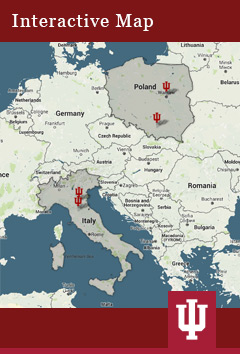New beginnings and the conclusion of a historic week in Poland and Italy
Four of the world’s most culturally vibrant cities. Three of the oldest and most highly esteemed universities. Two historically dynamic countries. One unforgettable week.
No matter how you calculate it, members of the IU delegation will carry countless memories back to Bloomington after what has been a highly productive, purposeful and inspiring weeklong trip through Italy and Poland.
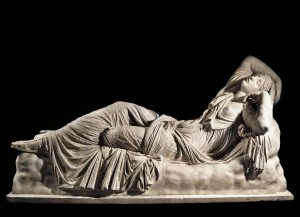
Arianna dormiente, a classical Roman sculpture, is one of the works from the Uffizi Gallery in Florence, Italy, that will be digitized in 3-D.
It was a week that started in sensational fashion — with the announcement of an unprecedented agreement with the Uffizi Gallery in Florence, Italy, that will result in the 3-D digitization of all 1,200 of the Greek and Roman sculptures housed at one of the world’s most renowned museums. It’s almost impossible to overstate the importance of this project and, specifically, the opportunities it will provide IU students and faculty to engage with an irreplaceable collection of art.
Just a few days later, IU delegation members experienced, first-hand, the historic bond between Bloomington and the ancient city of Bologna, where one of IU’s most successful study abroad programs has changed lives and created lifetime linkages between its hundreds of proud alumni. Many of those alumni returned to Bologna for a momentous 50th anniversary reunion celebration.
From beautiful Bologna, with its magnificent Baroque and Renaissance architecture, cultural splendor and, yes, mouth-watering cuisine (oh, how soon we won’t forget the pasta!), it was on to the equally breathtaking Krakow, one of Poland’s most important academic, artistic and cultural centers. Though 24 hours afforded little time to fully appreciate this spectacular city, IU found time to renew its relationship with Jagiellonian University, where such famous scholarly figures as Copernicus and Karol Wojtyla, later Pope John Paul II, received their academic training.
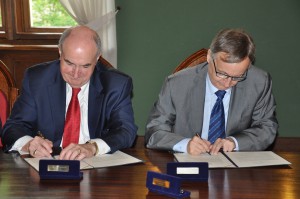
IU President Michael A. McRobbie, left, and Wojciech Nowak, president of Jagiellonian University, renew a partnership agreement between their respective institutions.
The partnership between IU and Jagiellonian University calls for an expansion in the number of faculty and graduate student exchanges that have taken place between the two universities for three decades now. Not to be forgotten was IU’s harmonious meeting with Maestro Krzysztof Penderecki, Poland’s greatest living composer, and his most gracious wife, Elzbieta. Maestro and Mrs. Penderecki’s anticipated arrival in Bloomington in early 2017 to receive an honorary doctorate from the university will almost certainly be a major highlight of the next academic year at IU.
Finally in Warsaw, a city thoroughly decimated and relegated to rubble during World War II, delegation members witnessed the remarkable resilience and rejuvenation of a country that has endured centuries of challenge and almost unfathomable tragedy. Today, though, Warsaw has positioned itself — through a determined effort to enhance its economy, education and democracy — as a central contributor to the success of the 21st-century European community.
Beyond the incredible sights, smells and sounds they experienced, however, members of the delegation could take great pride in knowing that the seeds sown here in Europe would soon benefit IU students and faculty back home. While we raced across Krakow and Warsaw for a series of meetings, a team of students and other scholars, led by IU informatics professor Bernie Frischer, had already begun work on the 3-D scans of some of the major sculptures in the Uffizi Gallery in Florence. Indeed, by renewing its most successful and productive partnerships and initiating several exciting new collaborations, IU has ensured greater opportunities for its students to broaden their knowledge and understanding of other cultures. What’s more, it’s helped to ensure that its students and faculty work with the most talented scholars and in the most intellectually inspiring places around the world.
Reflection and remembrance
Members of the IU delegation had the opportunity to tour one such location this morning in Warsaw. The POLIN Museum of the History of Polish Jews, which first opened in spring 2013, is truly a spectacular site. Housed in a post-modern, rectangular structure built from concrete, copper and glass, and designed by master Finnish architect Rainer Mahlamäki, it stands in what was once the heart of Jewish Warsaw — an area that the Nazi government turned into the Warsaw Ghetto during World War II. The Warsaw Ghetto was the largest of all of the Jewish ghettos in Nazi-occupied Europe during World War II. This symbolic setting — along with the museum’s proximity to the Monument to the Ghetto Heroes, which commemorates those individuals who lost their lives in the Warsaw Ghetto uprising — helps to serve the museum’s mission, which director Dariusz Stola neatly defines as “reflection and remembrance.”
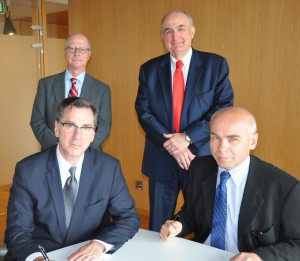
IU School of Global and International Studies Dean Lee Feinstein, left, and Dariusz Stola, director of the POLIN Museum of the History of Polish Jews, sign an internship agreement between IU and the museum. In back from left are IU Vice President for International Affairs David Zaret and President McRobbie.
The museum, which was named European Museum of the Year this year, seeks to recall and preserve the memory of the history of Polish Jews, contributing to greater mutual understanding and respect among Poles and Jews as well as other societies of Europe and the world. Secondarily, it aims to create a modern, multifunctional museum that provides an educational and cultural center, along with a platform for social dialogue.
The POLIN Museum, a six-story building made up of eight galleries, traces the story of Polish Jews, from the beginnings of Jewish settlement in Poland and rise of Jewish culture during several ensuring centuries to the horrors of the Holocaust. Through the use of photographs, artifacts, first-person accounts and interactive multimedia, the museum’s “Core Exhibition” leads visitors on a journey through 1,000 years of Jews in Poland, including what led them to settle in Poland, why they stayed and how the country eventually became home to one of the largest Jewish communities in the world — there were 3.3 million Jews in Poland before the Holocaust.
The Core Exhibition is directed by a wonderful IU alumna, Barbara Kirshenblatt-Gimblett. She worked with a team of more than 120 curators, scholars and designers on the exhibition, which opened to considerable fanfare less than two years ago. (A personal aside: I will never cease to marvel at the IU connections in important educational, political and cultural organizations all around the world!)
On Wednesday morning, Kirshenblatt-Gimblett kindly led IU President Michael A. McRobbie and his colleagues through a memorable tour of the exhibition’s galleries, each of which presents a different chapter of Polish Jews that enables visitors to come into intimate contact with those who wrote that story.
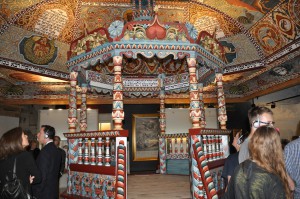
One of the standout piece in the POLIN Museum’s Core Exhibition is a wooden synagogue, originally built in the mid-17th century and painstakingly reconstructed by almost 400 volunteers from Poland and abroad.
Words truly can’t describe what it feels to walk through the Core Exhibition. Simply put, it’s an incredibly moving experience. Particularly memorable stopping points were a large map of all of the hundreds of cities, small towns and villages across the country where Polish Jews lived and worked; a wooden synagogue, originally built in the mid-17th century and painstakingly reconstructed by almost 400 volunteers from Poland and abroad; a railway station symbolizing the industrial revolution in the mid-19th century that led to a mass migration of more Jews to Poland and the growth of the country’s metropolises; and the gray, somber room representing the horrors and atrocities of the Holocaust, from which barely 300,000 Jews survived, most of them in the Soviet Union.
After the tour, Stola met members of the IU delegation, including McRobbie, Vice President for International Affairs David Zaret and Lee A. Feinstein, former U.S. ambassador to Poland and founding dean of the IU School of Global and International Studies, who has played a central role in the museum’s development. Feinstein currently sits on the North American Council of the museum; while serving as U.S. ambassador in 2011, he escorted President Barack Obama to the construction site of the museum. The discussions among the IU and museum leadership focused on linking the museum with various academic units at IU and leveraging the university’s considerable expertise — including in Jewish studies, Polish studies, Russian and East European area studies, foreign language instruction, arts administration and museology — to uphold the museum’s mission of supporting research and scholarly exchange on the history and culture of Polish Jews.

From left: IU Vice President for International Affairs David Zaret, President McRobbie and Marian Turski, chairman of the POLIN Museum Council. Turski is a survivor of the Auschwitz concentration camp who went on to a distinguished career in Poland as a journalist and Jewish activist.
As a major first step in what promises to be a terrific collaboration, McRobbie and Stola signed a new partnership agreement Wednesday between IU and the POLIN Museum that will create opportunities for talented IU undergraduate students to intern at the museum during the summer. Conversations about further IU and POLIN connections then continued over a most memorable lunch at the museum, including Stola, Kirshenblatt-Gimblett and two members of the POLIN Museum Council. The council representatives included two incredibly remarkable men: chairman Marian Turski, who survived the Auschwitz concentration camp and went on to a distinguished career in Poland as a journalist and Jewish activist, and professor, researcher and diplomat Adam Rotfeld, also a Holocaust survivor, who served as minister of foreign affairs for Poland and today is an authority on the political and legal structures of the security system in Europe and human rights.
In our short but memorable time together, members of the IU delegation learned that Turski marched with the Rev. Martin Luther King Jr. and — as yet another illustration of IU’s deeply rooted ties to Poland — spent quality time in Bloomington during the mid-1960s conducting research in the libraries of the School of Journalism and elsewhere around campus.
A historic and meaningful partnership
Despite the often breakneck pace of the delegation’s travels through Florence, Bologna, Krakow and Warsaw, we nevertheless were afforded time to consider IU’s powerful international ties and just how prescient past presidents, senior leaders and faculty were in pursuing opportunities for global engagement, no matter how complex the country or challenging the circumstance.
At the University of Warsaw, it was nearly impossible not to think back to 40 years ago and wonder what was going through the minds of the IU and University of Warsaw faculty who, at the height of the Cold War, joined together for scholarly collaboration at a time when such activities were few and far between.
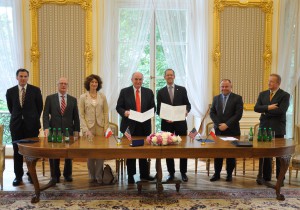
President McRobbie and Marcin Palys, president of the University of Warsaw, proudly display signed agreements renewing the 40-year partnership between their respective institutions.
Despite a lack of trust and misunderstanding that marked relations between the U.S. and the Soviet Union, visionary leaders at both institutions agreed in 1976 to engage in a partnership that led to the establishment of two area studies centers that have experienced great success over the past four decades: the American Studies Center here in Warsaw and the Polish Studies Center back in Bloomington.
To listen to members of the current University of Warsaw faculty talk is to understand how meaningful this partnership has been, both now and then. At a time when Polish scholars felt isolated from the rest of the world, in the 1970s and 1980s, IU’s connection with the American Studies Center in Warsaw was truly the first of its kind with a partner institution in east-central Europe, and the center’s library served as the only open access library east of Berlin. Many of those who used the center and who visited or attended IU graduated to major roles in academia, government and public policy, both before and after the fall of communism in 1989.
“I don’t know if people in Indiana have any idea how much [the partnership] meant to our country’s scholars,” professor Bohdan Szklarski, director of the American Studies Center at the University of Warsaw, said Wednesday afternoon. “Indiana University symbolized for Polish visitors what America stood for: freedom, opportunity and creativity. We returned to Poland with new ideas and open minds.”
In turn, the University of Warsaw has contributed greatly to the scholarly and intellectual life at IU. Through the partnership, dozens of IU faculty and graduate students have studied and taught in Poland, and an equal of number of scholars from the University of Warsaw have come to IU’s Bloomington campus.
In recent years, IU has also organized several important academic conferences and symposia and welcomed numerous influential Polish dignitaries — including former Polish president and Nobel Peace Prize recipient Lech Walesa and the late Nobel Laureate and celebrated Polish poet and novelist Czeslaw Milosz.
New beginnings
On Wednesday, McRobbie joined his University of Warsaw counterpart, President Marcin Palys, in signing a renewal of one of IU’s most successful international partnerships and meeting to discuss ways to fortify and further the collaboration for another 40 years. Accompanying McRobbie at the signing was Dean Feinstein, who forged a strong relationship with the University of Warsaw during his three years as ambassador to Poland, from 2009 to 2012, and Vice President Zaret, whose office oversees the central institutional partnership.
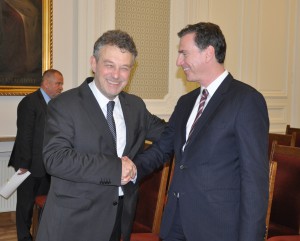
Polish Ambassador to the U.S. Ryszard Schnepf shares a laugh with Lee Feinstein, former U.S. Ambassador to Poland and founding dean of the IU School of Global and International Studies.
At the meetings, officials from both IU and UW agreed that the time is ripe for expanding student and faculty exchanges and research collaborations between the universities, and finding opportunities to extend the collaboration across various academic areas where the two universities share considerable strengths: the arts and humanities, area studies, business, language instruction, law, media and more.
Following the signing and meetings, McRobbie led IU’s participation in a special 40th anniversary celebration of the partnership, which featured several distinguished guests, including Polish Ambassador to the U.S. Ryszard Schnepf and past and present UW leaders.
To commemorate the occasion, the two universities launched the Krzysztof Michałek Memorial Lecture in American Studies, named for one of the former directors of the American Studies Center in Warsaw who also spent two years at IU as associate director of the Polish Studies Center. John Bodnar, IU Distinguished and Chancellor’s Professor of History, delivered the inaugural lecture at the celebration on the topic of war and memory.
On behalf of the entire IU delegation, McRobbie expressed our pride in reaffirming IU’s continuing and deep interest in Poland, a country of amazing resilience.
“That Poland has recovered and rebounded so successfully and dynamically after many decades of tragedy and horror to be once again one of the leading countries of Europe is a testimony to the extraordinary resilience and moral courage of the Polish people,” he said.
Fittingly for a celebration of 40 years of collaboration, Wednesday’s ceremony concluded with two major exchanges.

McRobbie presents the Thomas Hart Benton Medallion to Marcin Palys, president of the University of Warsaw, in recognition of the landmark and successful partnership between the two universities.
Following his speech, McRobbie presented the Thomas Hart Benton Mural Medallion to UW President Palys, in recognition of the landmark and successful partnership between the two universities. Palys later bestowed upon McRobbie UW’s prestigious Bicentenary Medal of the University, also in recognition of the 40 years of active partnership between the two institutions.
McRobbie focused his closing remarks on the future of the IU-UW collaboration. “As we celebrate the 40th anniversary of our partnership, and as the American Studies Center and the Polish Studies Center enter the next phase of their operation, I am confident that the partnership between our institutions will continue to thrive,” he said.
In the days and weeks that follow this memorable and inspiring trip, there will surely be many moments for members of the IU delegation to reflect upon the historic places and heralded programs we visited this week. Our POLIN Museum-based alum Barbara Kirshenblatt-Gimblett may have said it best, as she sought to maneuver us through 1,000 years of history in an hour — which was all the time we had to tour a museum in which one could spend days. There are three types of people she typically takes on tours, she said, “skimmers, swimmers and divers. … This is clearly a group of divers.”
Many decades ago, IU chose to take a deep dive into the most dynamic and historic parts of Europe, and I can proudly report that the results of that engagement — here in Poland and also in Italy — have made a remarkable difference in the lives of our students, our faculty and our alumni and friends in Indiana and all over the world.
Do widzenia, arrivederci and goodbye, and thanks to everyone for reading!
Tags: American Studies Center, Barbara Kirshenblatt-Gimblett, Bernie Frischer, Bologna, David Zaret, Florence, Indiana Alumni Association, Italy, IU Polish Studies Center, Jagiellonian University, John Bodnar, Krakow, Lee A. Feinstein, Marian Turski, Michael A. McRobbie, Poland, POLIN Museum of the History of Polish Jews, Ryszard Schnepf, Thomas Hart Benton Medallion, Uffizi Gallery, University of Bologna, University of Warsaw, Warsaw

